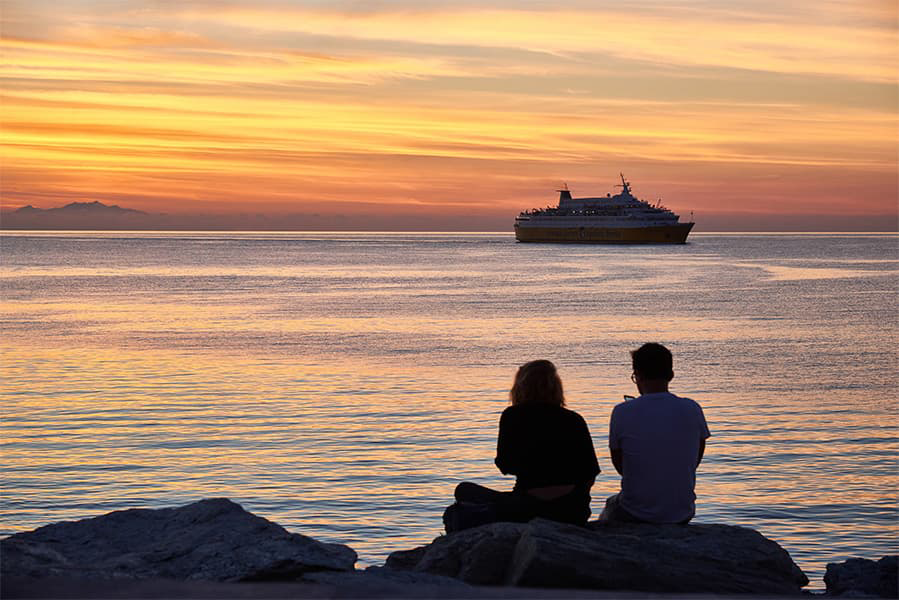Portoferraio – Cavo
Ferries to Elba
Portoferraio – Cavo
Ferries to Elba

There are usually 2 daily and 12 weekly sailings between Portoferraio and Cavo. This ferry route is operated by
The earliest Portoferraio Cavo ferry sailings typically depart Portoferraio at around 06:50. The last ferry usually departs at 13:10.
Portoferraio Cavo Ferry sail durations on this ferry route can take around 15m. The fastest sailings are approximately 15m. Sailing times can vary, durations often differ between ferry operators and can be impacted by weather conditions.
There are an average of 2 daily sailings and up to 12 weekly ferry sailings from Portoferraio to Cavo. These sailings are provided by Toremar. Please keep in mind that ferry timetables often increase during the high season.
Portoferraio Cavo ferry prices typically range between 33.25 €* and 33.25 €*. The average price is typically 33.25 €*. The cheapest Portoferraio Cavo ferry prices start from 33.25 €*. The average price for a foot passenger is 33.25 €*.
Pricing will vary depending on number of passengers, vehicle type, route and sailing times. Prices exclude service fees.
The distance between Portoferraio to Cavo is approximately 7.6 miles (12.2km) or 6.6 nautical miles.
No, ferry operators currently do not allow cars to travel on sailings between Portoferraio and Cavo
Yes, foot passengers can travel with
Pets are currently not allowed on board the ferries from Portoferraio to Cavo.
More routes than anyone else.

Compare fares, times & routes in one place.
Change plans easily with flexi tickets.

Book e-tickets & manage trips in-app.
Live ship tracking & real-time updates.

Top-rated customer support when you need it.
| Portoferraio - Cavo Route summary | ||
|---|---|---|
| Departure Country | Italy | |
| Destination Country | Italy | |
| No. of Operators | 1 | |
| Operators | Toremar | |
| Average Price | 33 €* | |
| Average Daily Sailings | 2 | |
| Average Weekly Sailings | 12 | |
| Average Sailing Duration | 15m | |
| First Ferry | 06:50 | |
| Last Ferry | 13:10 | |
| Distance | 6 nautical miles | |
* Prices subject to change, pricing is taken from last 30 days, last updated 2024-11-05.
The Italian town of Portoferraio is located in the Province of Livorno, on the edge of the harbour on the island of Elba. The town's name is derived from the Italian for "Iron Port", after the iron mills in and around the city. It is because of these mills that facilitated the city's growth during the 19th century. During this period the town became the main shipping port of profitable iron ore towards the mainland. Thanks to Napoleon's stay, as he was exiled in Elba in 1814 after his defeats in Europe and his forced abdication, Portoferraio and the entire island enjoyed an age of glory.
Arriving from the sea, Portoferraio seems like a bay, protected from pirates by it bastions which provide shelter from the sea. One of the most popular tourist attractions in the town are its ancient bastions and historic walls, which are fairly well preserved, and were built to provide protection to the town. Located nearby is the hamlet of Le Grotte, where visitors can see remains of a Roman villa dating back to the Imperial period. Until 1960, the ruins were covered by shrubs and plants, but excavation showed the extent of the complex with wall sin opus reticulatum, large terraces overlooking the sea and a pool with heating and water cycle system.
Ferry services from the town's harbour depart to Plombino, Bastia and Cavo.
The town and port of Cavo is located on the Italian island of Elba, the largest of the island in the Tuscan Archipelago and Italy's third largest, after Sardinia and Sicily. It also forms the National Park of the Tuscan Archipelago, Europe's largest marine park, along with Giglio, Giannutri and Montecristo. The island is perhaps most famous for harbouring French Emperor Napoleon in 1814 during his exile, although the island's history goes back much further than this. It dates back to prehistory with the Ilvati tribe from Liguria who named the island Ilva and then later inhabited by the Etruscans and then later still by the Romans who liked the island because of its rich deposits of iron ore and its mud baths. The island's archaeological findings, contained in its museums, the impressive fortresses and military buildings such as Castello del Volterraio and the beautiful Napoleonic residences of the 1800's such as Palazzina dei Mulini all bear testament to the island's past.